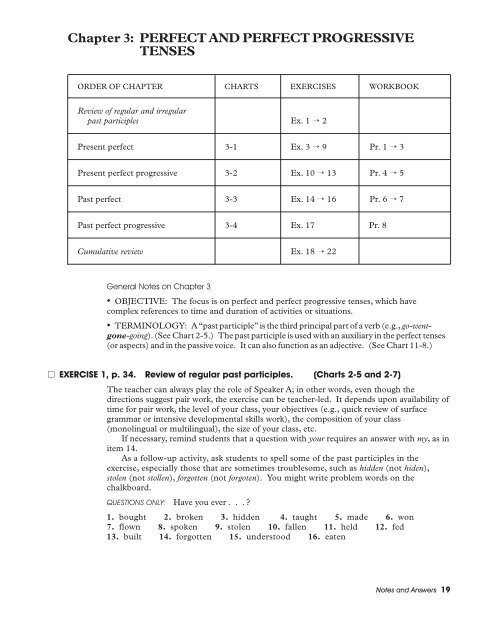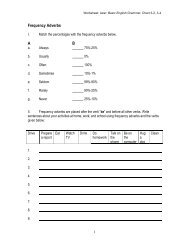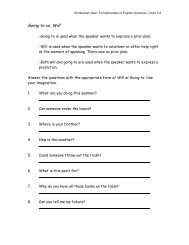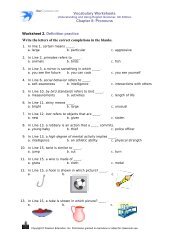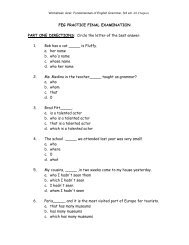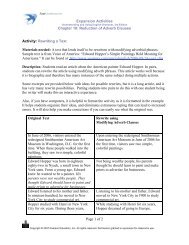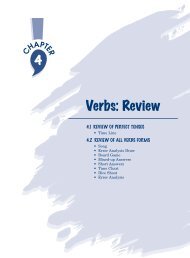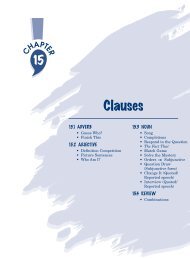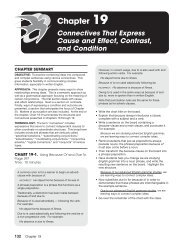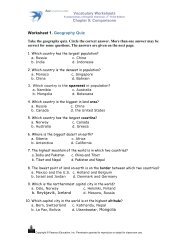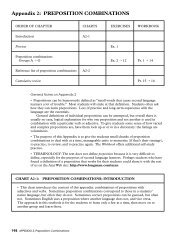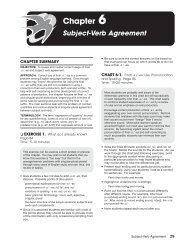Chapter 3 - AzarGrammar.com
Chapter 3 - AzarGrammar.com
Chapter 3 - AzarGrammar.com
You also want an ePaper? Increase the reach of your titles
YUMPU automatically turns print PDFs into web optimized ePapers that Google loves.
<strong>Chapter</strong> 3: PERFECT ANDPERFECT PROGRESSIVETENSESORDER OF CHAPTER CHARTS EXERCISES WORKBOOKReview of regular and irregularpast participles Ex. 1 → 2Present perfect 3-1 Ex. 3 → 9 Pr. 1 → 3Present perfect progressive 3-2 Ex. 10 → 13 Pr. 4 → 5Past perfect 3-3 Ex. 14 → 16 Pr. 6 → 7Past perfect progressive 3-4 Ex. 17 Pr. 8Cumulative review Ex. 18 → 22General Notes on <strong>Chapter</strong> 3• OBJECTIVE: The focus is on perfect and perfect progressive tenses, which have<strong>com</strong>plex references to time and duration of activities or situations.• TERMINOLOGY: A “past participle” is the third principal part of a verb (e.g., go-wentgone-going).(See Chart 2-5.) The past participle is used with an auxiliary in the perfect tenses(or aspects) and in the passive voice. It can also function as an adjective. (See Chart 11-8.) EXERCISE 1, p. 34. Review of regular past participles. (Charts 2-5 and 2-7)The teacher can always play the role of Speaker A; in other words, even though thedirections suggest pair work, the exercise can be teacher-led. It depends upon availability oftime for pair work, the level of your class, your objectives (e.g., quick review of surfacegrammar or intensive developmental skills work), the <strong>com</strong>position of your class(monolingual or multilingual), the size of your class, etc.If necessary, remind students that a question with your requires an answer with my, as initem 14.As a follow-up activity, ask students to spell some of the past participles in theexercise, especially those that are sometimes troublesome, such as hidden (not hiden),stolen (not stollen), forgotten (not forgoten). You might write problem words on thechalkboard.QUESTIONS ONLY: Have you ever . . . ?1. bought 2. broken 3. hidden 4. taught 5. made 6. won7. flown 8. spoken 9. stolen 10. fallen 11. held 12. fed13. built 14. forgotten 15. understood 16. eatenNotes and Answers 19
EXERCISE 2, p. 35. Review: regular and irregular past participles.(Charts 2-5 and 2-7)You may need to explain that ever in a present perfect question means “at least once in yourlifetime.” It is not used in the answer to a question.An acceptable alternative to the answer “No, I haven’t” is “No, I never have.”Instead of pair work, this exercise can be teacher-led. The students’ books are closed.You say the cue phrase. Then Speaker A asks B a question, and B answers truthfully. If youwish, you may expand some of these short dialogues. After Speaker B replies “Yes, I have,”you might ask when or where the event occurred.QUESTIONS ONLY: Have you ever . . . ?1. climbed 2. written 3. been 4. told 5. smoked 6. ridden7. taught 8. seen 9. met 10. given 11. eaten 12. studied13. played 14. gone 15. walked 16. watched 17. taken 18. driven19. fallen 20. had 21. driven 22. read 23. drawn 24. ridden25. caught 26. slept 27. written 28. lost 29. had 30. brought31. worn 32. drunk 33. left 34. dug 35. shaken 36. sungCHART 3-1:PRESENT PERFECT• Compare the example sentences with similar sentences in the simple past; e.g., They havemoved into a new apartment vs.They moved into a new apartment last week.• The use of the present perfect illustrated by examples (l) though (p) carries the samemeaning as the present perfect progressive: it expresses the duration of an activity that beganin the past and continues to the present. The present perfect is used to express the duration ofa “state,” but the present perfect progressive is used to express the duration of an “activity.”Note that all the verbs in (l) through (p) are stative. (See Chart 2-3.)• Special attention may need to be paid to (h) and (n), where have is an auxiliary and had isthe main verb. EXERCISE 3, p. 36. Present perfect vs. simple past. (Charts 2-9 and 3-1)ANSWERS: 2. went 3. arrived 4. has been 5. have already missed . . .missed 6. have had 7. has drawn . . . drew 8. has called . . .called 9. has worn . . . wore 10. has risen . . . rose 11. saw12. has never seen [never saw would mean that either Fatima is now dead or you are tellinga story about a fictional character whose story took place in the past.] 13. have known[knew would mean that Greg Adams is, in all likelihood, dead.] 14. has just arrived / justarrived 15. haven’t been . . . hasn’t responded . . . started . . . have faxed . . .have phoned . . . have sent20 CHAPTER 3, Perfect and Perfect Progressive Tenses
EXERCISE 4, p. 37. Present perfect. (Chart 3-1)If teacher-led, this exercise can be expanded by eliciting similar sentences using the simplepast: e.g., How many books have you bought since the beginning of the semester? can be followedby When did you buy this book?As with any teacher-led oral exercise, omit items irrelevant to your particular class andmake up additional items directly related to your students’ lives and situations.This kind of question-and-answer oral exercise is a good opportunity to get yourstudents talking about themselves. Ask more than one student the same question. Followup interesting responses by engaging in short dialogues with your students. Questions thatyou ask conversationally on the topics suggested in the exercise can provide the studentswith excellent oral practice of verb tenses. In addition, you can learn more about yourstudents and they about each other. They may discover, for instance, that others in theclass are having trouble meeting people and making friends (item 7), or that others misshome cooking and dislike what is offered in the student cafeteria (item 11).POSSIBLE RESPONSES: 1. I’ve bought six books . . . . OR I haven’t boughtany . . . . 2. I’ve gotten two . . . . OR I haven’t gotten any . . . .3. I’ve written three . ... OR I haven’t written any . ... 4. You’ve asked threequestions . . . . 5. I’ve flown many times . ... 6. I have made dinner manytimes . . . . 7. I’ve met lots of people . ... 8. I haven’t missed anyclasses . . . . 9. I’ve had two cups . . . . 10. I’ve had four classes . . . .11. I’ve eaten at a restaurant several times . . . . 12. I’ve ridden a bike lots of times. EXERCISE 5, p. 38. Present perfect. (Chart 3-1)Frequent problems occur with the word “since.” Since may be followed by (1) a specific dayor date (1998, Friday, last January, etc.) or (2) a clause with a past tense verb (since I wastwelve years old, since he came to this city, etc.). Point out that it is incorrect to use durationalphrases like since two years or since a long time. In those cases, for is used.It is advisable to discourage the use of time phrases with ago following since (e.g., sincethree days ago). Such phrases are sometimes used very informally by native speakers, forinstance in a short answer, but are likely to be misused by the learners at this point.Example of possible informal usage:A: You can’t drive. You don’t have a license.B: Yes I do.A: You do? Since when?B: Since two weeks ago!NOTE: In usual usage, a person would say: “I’ve had my driver’s license for two weeks” NOT“I’ve had my driver’s license since two weeks ago.”SAMPLE RESPONSES: 2. two weeks . . . two weeks . . . the twenty-second ofSeptember 3. October 2. . . September 2 OR one month ago . . . September 2 . . .one month 4. 1999 . . . 1981 . . . eighteen years . . . 1981 5. In October . . .three months . . . October EXERCISE 6, p. 39. Present perfect. (Chart 3-1)FORMAT: After one student replies, the leader asks another student about the first one’sresponse.If student-led, this exercise gives small groups the opportunity to begin with astructured format and then, it is hoped, proceed to incidental <strong>com</strong>municativeinteraction.If the exercise is teacher-led, some of your exchanges with students might lead toexpansion of the dialogue into a brief conversation. If it seems natural and interesting, keepit going for a minute or two.Notes and Answers 21
EXERCISE 7, p. 39. Present perfect. (Chart 3-1)You can either have the students repeat after you, or have the students read the sentenceswith the contracted forms first and then repeat after you. Make up additional sentences asyou and the students wish. (E.g., How long’ve you been living here? Why’s Juan stopped<strong>com</strong>ing to class? Etc.)It is not necessary for students to use these contractions when they speak, but they arenatural for native speakers of English. The main point here is to make the class aware thatthese contractions with nouns and question words exist so that the students might be morelikely to notice them when listening to native speakers.Students sometimes hesitate to use contractions. The result is that their speechsounds stilted and formal in conversations. Comfortable use of contractions <strong>com</strong>esthrough experience. You can encourage your students to use contractions but should notrequire it.ITEM NOTES: 3. “weather’s” been 4. “neighbors’ve” asked 5. “teacher’s” nevereaten 6. (no contraction;“has” is the main verb) 7. “parents’ve” lived 8. (nocontraction;“have” is the main verb) 9. “Where’ve” you been? 10. “What’ve”you done EXERCISE 8, p. 40. Present perfect vs. simple past. (Charts 2-9 and 3-1)Point out spoken contractions.ANSWERS: 1. came . . . have you made 2. haven’t had . . . have had 3. had . . .went [Last night signals the simple past; both actions occupied the same time period.] 4. havegotten/got [got is principally British usage.] . . . saw . . . have also gotten/got [got is principallyBritish usage.] 5. advanced 6. have made 7. have changed . . . were . . . havebe<strong>com</strong>e [today = in modern times, in contemporary life, these days] ... has also changed . . .were 8. have already taken . . . took 9. A: Have you ever met B: haven’t10. have never eaten 11. [The most <strong>com</strong>mon use of the present perfect is without timesignals, as illustrated in the first two blanks.] Have you eaten . . . have already eaten . . . havejust finished OR Did you eat . . . already ate . . . just finished 12. A: have youvisited [no time signal] B: have been [no time signal] A: have never been . . . wereyou [asking for a specific time signal] B: also visited [no time signal—not two years ago, but adifferent trip] . . . took [six years ago] A: did you visit [referring to the trip six years ago] *A: have always wanted . . . haven’t had . . . went . . . haven’t gone EXERCISE 9, p. 41. Activity: using the present perfect. (Chart 3-1)You might want to give students some limit on the length of (or amount of detail in) theirwritten answers. A lengthy or detailed answer will require use of the simple past as well asthe present perfect and could serve as practice in using both tenses. In evaluating theanswers, reward each correct use of the present perfect. You might choose simply to notemisspellings and other errors without focusing on them.In preparation for (or possibly instead of) writing their answers, students could discussthem in small groups. Each member of the group could give an answer as the rest of thegroup listens for the use of the present perfect. At the end of the speaker’s answer, theothers could identify (orally or in writing) what the speaker said, copying or correcting thespeaker’s use of the present perfect.*The separate Answer Key booklet mistakenly gives the present perfect as a possible answer for thisblank. The author apologizes for the confusion—and sometimes wonders what little grammargremlins sneak in and cause printed errors! The correct <strong>com</strong>pletion for this blank is did you visit;have you visited is NOT correct.22 CHAPTER 3, Perfect and Perfect Progressive Tenses
Another alternative is to divide the class into five groups. Each group discusses oneitem. Each student writes a summary of everything that was said in his/her group, or theleader of each group presents an oral summary to the rest of the class. (You might want toexpand the scope of item 3 to include “Why?” “Do you ever expect to do these things?”and “What are some interesting and unusual things that you have done and want to doagain?”)CHART 3-2:PRESENT PERFECT PROGRESSIVE• Compare the examples with the present progressive. (See Chart 2-2.) Explain that bothtenses deal with actions in progress, but that the present progressive simply states that anaction is in progress at the moment of speaking, while the present perfect progressive gives theduration up to now of an action in progress now.• Expect students to have difficulty understanding the use of this tense in examples (g), (h), and (i).• As noted in (j) and (k), sometimes there is little or no difference between the present perfectand the present perfect progressive in sentences with since or for, often depending on the typeof action the verb describes. There is, however, often a subtle preference for one or the otherby native speakers in certain situations. The present perfect may be preferred for longstandingactivities (Jack has worked at the ABC Company since he graduated from college 40 years ago) andthe present perfect progressive for temporary or recent activities (Jack has been working on theX Project since its inception two months ago). In these cases, however, either tense is usuallypossible and correct (Jack has been working at the ABC Company since he graduated from college40 years ago AND Jack has worked on the X Project since its inception two months ago).The present perfect progressive is generally preferred over the present perfect to expressthe duration of an activity from a point in the past to the present—except, of course, in thecase of stative verbs, which are not used in any progressive and use the present perfect toexpress duration: I have known Jack since he graduated from college. EXERCISE 10, p. 42. Error analysis: present perfect progressive. (Chart 3-2)This exercise is intended solely as further clarification of the information in the precedingchart. It is intended for discussion. Give the students two or three minutes to find theerrors themselves prior to class discussion.The items present situations in which only the present perfect progressive isappropriate. Review the meanings of the incorrect tenses and <strong>com</strong>pare them to the presentperfect progressive.ANSWERS: 1. They have been playing for almost two hours. 2. He has been talking onthe phone for more than half an hour. 3. I have been trying to study for the last hour,but something always seems to interrupt me. 4. He has been waiting there for the lasttwenty minutes.Notes and Answers 23
EXERCISE 11, p. 43. EXERCISE 12, p. 44. EXERCISE 13, p. 45.Present perfect vs. present perfect progressive.(Charts 3-1 and 3-2)Notice in items 1, 3, maybe 6 and 7B, and possibly 12 that the present perfect simpleinstead of progressive would not necessarily be grammatically incorrect, but native speakerswould use the progressive form.ANSWERS: 1. has been snowing 2. have had 3. have been studying 4. havewritten 5. has rung 6. has been ringing 7. Have you been . . . have beentrying 8. haven’t seen . . . have you been doing 9. have never had 10. Haveyou been crying? 11. A: has he been B: has been teaching/has taught 12. hasbeen playingPresent perfect and present perfect progressive withSINCE and FOR. (Charts 3-1 and 3-2)Students may use either the present perfect or the present perfect progressive. You maychoose to ask them for both.The exercise can be done as a teacher-led oral review, as group or pair work, or aswritten work.Activity: using the present perfect and present perfectprogressive in writing. (Charts 3-1 and 3-2)This is a summary review activity for both the present perfect and present perfectprogressive, as well as the simple past.Perhaps brainstorm a sample <strong>com</strong>position with the students by discussing both topics.It could be fun for the class to share some of their experiences and will get them thinkingabout what they might write. Prior discussion of topics often leads to better <strong>com</strong>positions.For item 1, if the students seem shy about speaking frankly of their experiences in this class,ask leading questions: “What was your first impression of this building? this room? What doyou remember about your classmates the first day? your teacher? Who did you talk to?What did we do the first day of class? How did you feel about taking this class in (grammar,<strong>com</strong>position, etc.)? Were you excited about studying grammar? Did you think the class wasgoing to be too easy? too hard? What were your concerns? Were you concerned about thelevel of your English ability?” Etc. Then move into questions with the present perfect:“How long have you been attending this class? What topics of English grammar have westudied? What are some of the fun things we’ve done in this class since that first day?”(NOTE: The responses to some of these questions might appropriately slip into the simplepast; for example, a student might say: “I really enjoyed the pantomimes we did.”) “What isone of the things you’ve enjoyed most in this class? How many <strong>com</strong>positions have youwritten? How many tests have we had? How many grammar exercises have we done?” Etc.Prepare some leading questions for item 2 also.24 CHAPTER 3, Perfect and Perfect Progressive Tenses
CHARTS 3-3 AND 3-4:PAST PERFECT AND PAST PERFECTPROGRESSIVE• Compare the examples with similar sentences containing (1) the present perfect and presentperfect progressive; and (2) the simple past. For example, in Chart 3-3: Sam has already leftand Sam left vs. Sam had already left. In Chart 3-4: The police have been looking for thecriminal for two years vs. The police had been looking for the criminal for two years before theycaught him.• Point out that two past events or times are necessary in order to use the past perfect. Theearlier event uses the past perfect tense. The progressive form may be used to expressduration or recency.• You might anticipate that students sometimes have the erroneous idea that the past perfectis used to express an event that happened a long, long time ago. In using the past perfect,when an event occurred in the past is important only in relation to another time in the past.• The expression “by the time” usually needs some explanation. It conveys the idea that oneevent was, or will be, <strong>com</strong>pleted before another event. It usually signals that either the pastperfect (simple or progressive) or the future perfect (simple or progressive) needs to be used inthe main clause. In fact, this phrase is used to signal only those tenses in the exercises in thetext — even though it is possible to use other tenses when a “state” rather than an “event” isbeing expressed: e.g., The doctor came at six. By that time, it was too late (state). The patientwas dead (state) OR had died (event).• In (b) and (c), the simple past may be used in informal English. In other words, it is often,but by no means always, possible to use the simple past in place of the past perfect. The pastperfect is relatively formal; the past perfect progressive is relatively infrequent. Students canexpect to find these tenses more useful in written English than in everyday spoken English,with the possible exceptions of their use in conditional sentences (<strong>Chapter</strong> 20) and in nounclauses that report speech (<strong>Chapter</strong> 12). EXERCISE 14, p. 46. Contracting HAD. (Appendix Chart C)Items 1 and 2 review contractions with pronouns. Item 2 points out that the contraction forhad and would is the same: apostrophe (’) + d. One can determine which auxiliary is beingcontracted by looking at the verb form that follows ’d. If it’s the past participle, ’d = had. Ifit’s the simple form of a verb, ’d = would.Items 3, 4, and 6 require students to supply the spoken contractions with nouns.Item 5 distinguishes between had as an auxiliary and had as a main verb, and how thataffects its contractibility. Main verb had is not contracted — except rarely and perhaps a bitpoetically to show possession; for example, I’d a lamb for a pet when I was a boy. By<strong>com</strong>parison, a native speaker would probably not say, “We’d a test yesterday” OR “They’ddinner last night at Luigi’s.”Items 7 and 8 contain contractions with question words (with the contracted formsboth spoken and written).ANSWERS: 3. children/əd/ 4. roommates/əd/ 5. [No contraction is possible because hadis the main verb.] 6. flood/əd/ 7. Where’d [spoken as a single syllable /wεrd/, but note that/d/ before /y/ in you be<strong>com</strong>es / ǰ/ = Where-/ǰu/] 8. Who’d [hud]Notes and Answers 25
EXERCISE 15, p. 46. Simple past vs. past perfect. (Charts 2-9 and 3-3)Note the contracted forms for the students.ANSWERS: 1. was/had been . . . became 2. felt . . . took/had taken 3. had alreadygiven . . . got 4. was . . . had stopped 5. roamed [Emphasize that the past perfect isNOT used simply because something happened a long time ago; the use of the past perfect requirestwo events in the past, one of which occurred before the other.] ... had be<strong>com</strong>e . ..appeared 6. had never seen . . . visited 7. saw . . . hadn’t seen . . . didn’trecognize . . . had lost 8. emigrated . . . had never traveled . . . settled . . .grew . . . went . . . had always wanted EXERCISE 16, p. 47. Past perfect. (Chart 3-3)In these sentences, review once again that the earlier or first action is in the past perfect andthe later or second action is in the simple past.It’s possible to expand the scope of this exercise by asking the students to write a shortparagraph (for each item, one item, or several items) in which the sentence based on the cuein the text is embedded in a context that the student creates. For example, in item 2:I was supposed to pick my cousin up at the airport last Friday at five in the afternoon.I left my apartment at three and thought I would have plenty of time to get to the airport before hisflight arrived. Unfortunately, I got caught in rush hour traffic. By the time I got to theairport, he’d already left. He thought I’d forgotten to meet him, so he took a taxi to myapartment.ANSWERS:[These depend on students’ creativity.] EXERCISE 17, p. 48. Present perfect progressive and past perfect progressive. (Charts 3-2and 3-4)The past perfect progressive is not a <strong>com</strong>mon tense. This is the only exercise that focuseson it, although it will be revisited in the chapter on conditional sentences and (briefly) inthe noun clause chapter. The intention here is simply to clarify its meaning and use by<strong>com</strong>paring it to a tense the students are already familiar with, the present perfectprogressive.ANSWERS: 3. have been studying 4. had been studying 5. had beendaydreaming 6. have been sleeping EXERCISE 18, p. 48. Review of verb tenses. (<strong>Chapter</strong>s 1 → 3)ANSWERS: 2. Gloria [Riding her bicycle was in progress at the time the rain stopped, meaning shebegan to ride her bike before the rain stopped. Paul rode his bicycle after the rain stopped; the whenclausehappens first when both clauses contain the simple past.] 3. Ken [Ann went to the storeafter she had run out of food. Ken went to the store while running out of food was inprogress.] 4. Mr. Sanchez [taught for nine years — the simple past indicates that the activity was<strong>com</strong>pleted in the past; has taught for nine years — he is still teaching; the activity is not <strong>com</strong>pleted.]5. Alice [George walked to the door only after the doorbell rang. Alice knew someone was <strong>com</strong>ingto ring her doorbell because she began to walk toward the door before the bell rang.]6. Joe [Maria finished eating before I arrived. Joe ate after I got there, so he was the one who wasstill hungry.] 7. Carlos. [similar to item 4] 8. Jane [Sue’s lying in the sun was still inprogress when she applied lotion. Jane’s lying in the sun had been recently <strong>com</strong>pleted when sheapplied lotion.] 9. Mr. Fox. [Mr. Fox’s waving was already in progress when I looked acrossthe street.]26 CHAPTER 3, Perfect and Perfect Progressive Tenses
EXERCISE 19, p. 49. Error analysis: present and past verbs. (<strong>Chapter</strong>s 1 → 3)See the Introduction, p. xviii, for suggestions for handling error analysis exercises.ANSWERS:1. Since I came to this country, I have learned a lot about the way of life here.2. Before I came here, I had never bought anything from a vending machine.3. I arrived here only a short time ago. I have been here only since last Friday.4. When I arrived here, I didn’t know much about the United States. I had seen manymovies about America, but that wasn’t enough.5. My understanding of this country has changed a lot since I arrived.6. When I was in my country, I coached a children’s soccer team. When I came here, Iwanted to do the same thing. Now I am coaching a soccer team at a local elementaryschool. I have been coaching this team for the last two months.7. My grandfather lived in a small village in Italy when he was a child. At nineteen, hemoved to Rome, where he met and married my grandmother in 1947. My father wasborn in Rome in 1950. I was born in Rome in 1979.8. I have been living / have lived in my cousin’s apartment since I arrived here. I haven’tbeen able to find my own apartment yet. I have looked at several places for rent, but Ihaven’t found one that I can afford.9. How long have you been living here? I have been here for almost two years.10. Why haven’t you been in class the last couple of days? EXERCISE 20, p. 49. Activity: using verb tenses. (<strong>Chapter</strong>s 1 → 3)The stories may get a little silly, but it is hoped the students will have fun.Be sure students understand that their contributions need to contain the cue words,chosen by them at random. EXERCISE 21, p. 50. Activity: using verb tenses. (<strong>Chapter</strong>s 1 → 3)Each person in the group is to begin a story. In a group of six people, six different storieswill be circulating at the same time.A time limit (two to three minutes per contribution) is advisable, unless you wish tomake this an activity that takes up an entire class period. If you use a strict time limit, anunfinished sentence can be <strong>com</strong>pleted by the next writer.After the stories are written and you are discussing them in class, you may or may notwish to bring up the possibility of using present tenses in a narrative. For example: Let metell you about Pierre’s day yesterday. He gets in trouble as soon as his alarm clock rings. When hehears the alarm and gets out of bed, he steps on a snake! Would you believe that? He’s nearlyfrightened to death, but the snake slithers away without biting him. Etc. The text doesn’t dealwith this use of the simple present, but you might want to explore it with an advanced class.This use of the simple present is <strong>com</strong>mon when telling jokes. EXERCISE 22, p. 50. Using verb tenses in writing. (<strong>Chapter</strong>s 1 → 3)Suggest a desirable length for the assignment, e.g., six to ten sentences, or 300–400 words,depending on your purposes and the emphasis on writing and <strong>com</strong>position in yourparticular class.The questions are intended only to guide the students’ ideas. Tell the students not tosimply answer each question in order. The questions in the text are only prompts to startthe students thinking about the topic.If you wish, ask the students to try to use each of the tenses studied so far at least once.List them on the chalkboard or identify them in Chart 1-5.Notes and Answers 27
As preparation for the writing assignment, ask leading questions about the topics to getthe students thinking about what they might write about. Discuss the meaning of “the stateof the world” by asking the students to describe the state of the world today.In marking the papers, focus mainly on verb tenses. Praise emphatically correct verbtense usage. One suggestion: mark but do not correct errors in verb tense; correct all othererrors yourself. If development of all writing skills is one of the principal goals in yourclass, however, you will probably want the students to correct most of their errorsthemselves.SUGGESTION: Make up your own error analysis exercise by copying incorrectsentences from the students’ writing and giving them to the class for discussion. Focuson verb tense errors. Include other miscellaneous errors if you know that the classknows the correct underlying grammar. Edit the student writing somewhat; don’tinclude errors that would get you into a whole new discussion of unfamiliar grammar.For example:Student writing: I enjoied to grow myself up in Mexico City. I had had a happy child timethere. My parents taked good care of there childrens.Used as an error analysis exercise item: I enjoied growing up in Mexico City. I had had ahappy childhood there. My parents taked good care of there childrens.One last note:You may notice that some errors in verb tense usage seem to be theresult of the students’ study of verb tenses. For example, you may notice students tryingto use the past perfect more than they had previously, but not always using it correctly.Don’t despair. It’s natural and does not seem to be of any lasting harm. View thestudents as experimenting with new tools. Praise them for reaching out toward what isnew usage for them, even as you correct their errors. Their study of verb tenses isproviding a foundation for growth as they gain experience and familiarity with English.Grammar usage takes time to gel. Don’t expect sudden mastery — and make sure yourstudents don’t expect that either. Encourage risk-taking and experimentation; studentsshould never be afraid of making mistakes. In language acquisition, a mistake is nothingmore than a learning opportunity.28 CHAPTER 3, Perfect and Perfect Progressive Tenses


